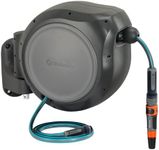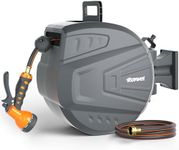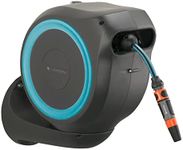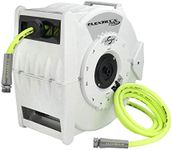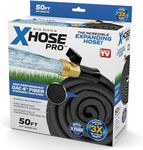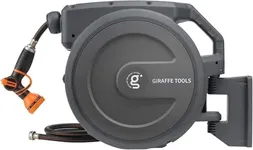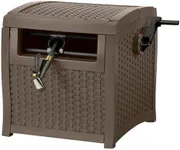Buying Guide for the Best Retractable Hoses
Choosing a retractable hose can make watering your garden or cleaning tasks much easier and more organized. The right hose will save you time, reduce tangles, and help keep your outdoor space tidy. When shopping for a retractable hose, it's important to consider a few key features that will affect how well it fits your needs and how convenient it is to use. Understanding these features will help you make a choice that matches your garden size, water pressure, and storage preferences.Hose LengthHose length refers to how far the hose can reach when fully extended. This is important because it determines how much area you can cover without moving the hose reel. Shorter hoses, such as those under 30 feet, are best for small patios or balconies. Medium lengths, around 50 feet, suit average-sized gardens, while longer hoses, 75 feet or more, are ideal for large yards. To pick the right length, measure the farthest distance from your water source to where you need to reach, and choose a hose that covers that distance comfortably.
Hose DiameterThe diameter of the hose affects how much water flows through it. Common diameters are 1/2 inch, 5/8 inch, and 3/4 inch. A smaller diameter is lighter and easier to handle, making it good for light watering tasks. Larger diameters allow more water to flow, which is helpful for filling pools or using sprinklers. Consider what you’ll use the hose for most often—if you need strong water flow, go for a larger diameter; for simple watering, a smaller one will do.
Retracting MechanismThe retracting mechanism is what pulls the hose back into the reel. Some hoses use a spring-loaded system, while others use water pressure or manual winding. Spring-loaded systems are the most common and offer quick, automatic retraction, but can sometimes snap back quickly. Water-powered systems are smoother but less common. Manual winding gives you full control but requires more effort. If you want convenience and speed, look for a reliable automatic system; if you prefer more control, manual might be better.
Mounting OptionsMounting options refer to how and where you can install the hose reel. Some are designed to be wall-mounted, saving space and keeping the hose off the ground, while others are portable and can be moved around your yard. Wall-mounted reels are great for permanent setups and small spaces, while portable ones offer flexibility if you need to use the hose in different locations. Think about where you’ll use the hose most and whether you want it fixed in one spot or to move it around.
Hose MaterialThe material of the hose affects its durability, flexibility, and resistance to kinks. Common materials include vinyl, rubber, and reinforced plastics. Vinyl hoses are lightweight and affordable but may not last as long. Rubber hoses are more durable and flexible, especially in cold weather, but can be heavier. Reinforced hoses combine materials for extra strength and kink resistance. If you need a hose for frequent or heavy-duty use, choose a more durable material; for occasional light use, a basic vinyl hose may be enough.
Nozzle and FittingsNozzle and fittings are the parts that connect the hose to the water source and control the spray. Good quality fittings, often made of brass or metal, are less likely to leak or break than plastic ones. The nozzle should offer adjustable spray patterns for different tasks, like watering plants or washing a car. If you want versatility and long-lasting performance, look for sturdy fittings and a nozzle with multiple spray options.
